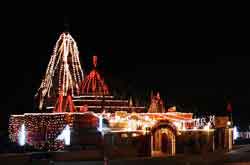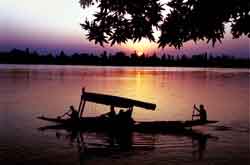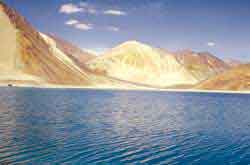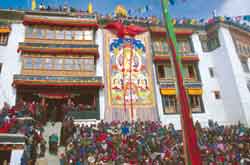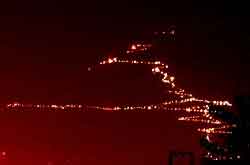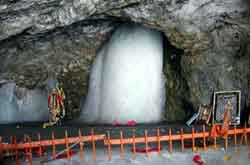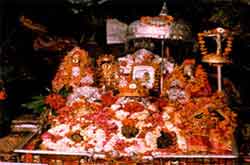Drokhpas and the ant’s Gold (Part-I)
An article by M. Ashraf, former Director General of Tourism, Jammu & Kashmir
Recently the Government of India opened a new tourist area for foreigners in Ladakh. It is the Batalik area of Kargil adjacent to Line of Control. This area is famous for the strange tribes known as Drokhpas.
There are many theories about the origin of these tribal people who are unlike other inhabitants of Ladakh. The area is approachable both from Leh through Khalsi and from Kargil through Batalik. Earlier tourists were allowed only through Khalsi up to Dah and Hannu. Now they can visit these places through Kargil also.
The main villages are Dah, Hannu, Garkon, Darchik, and Biama. There are also other smaller settlements. These people have very strange customs and a different life style. They are allergic to cow. They do not eat eggs and chicken. The source of their main supply of meat and the milk is goat. They eat goat cheese and store it for years. They worship deities whom they call Lha and Lhu. Their deities come from within the earth as well as from the sky and these also have some connection with fairies.
The area grows grapes from which these people make excellent wine. The most important occasion to know their true history is the harvest festival which they call Banono. This is an event full of gaiety. On this occasion people from different villages assemble in one place and celebrate for 5 days. The festival begins with the head of the tribe relating the story of their arrival in Ladakh. The festival which carries on for five days is a place to drink, dine, dance, and make free love! It is reported that many German ladies had been visiting the area to share their love with pure Aryan blood!
The head of the tribe recites 18 hymns relating to their history according to which they are supposed to have come through Gilgit. On the other side of the border there is a similar tribe called Kalash. In fact, there are strong theories that these tribes living on the two sides of the border in Ladakh including the Hunzakuts are remnants of Alexander’s Army. Some research scholars from Macedonia have conducted studies on the Hunza people and claim these to be Macedonians who remained behind after Alexander’s Army left the area. Apparently, the people inhabiting these villages are distinctly of non-mongoloid stock. Some of these people are very much like Europeans. Good looking, with aquiline noses and quite a few of these are blonde.
My first contact with the area was in 1974. My colleague Rauf and I had gone to survey facilities for tourists in Leh in July, 1974. On our return we spent a night in Khalsi with my late friend Benjamin Deldin. Benjamin and I had been class fellows in the Regional Engineering College, Srinagar in early sixties. He was those days working as an Assistant Engineer and was constructing the road from Khalsi to Dah. He was very keen that I should visit the area of these strange tribes. We started about 8’clock in the morning as the road was very rough. It was just the first earth cutting with very rough driving area.
The road follows the Indus River and some places it is along a steep fall into the River. There are a number of dry beds of streams going into the River with fine shingle over these. We took almost 3 hours to reach Dah. In the way, Benjamin was also inspecting various works. We stopped in Dah for lunch which we had carried along.
My first impression of these people was quite fascinating. They appeared to me characters from some Hollywood movie. Women are very beautiful and look absolutely like Europeans. Men are unimpressive. They live in stone houses. Each house has a balcony full of flowers. Both the men and women are fond of decorating themselves with various things including different types of flowers.
After spending some time among these tribals we returned to Khalsi. The return journey in the dark was quiet dicey. Our driver mistook the dry beds of streams as bends in the road and we had a narrow escape. Had he not realised in time, we would have descended straight into Indus River. The road has since been upgraded and with a bridge near Garkon it is connected with Kargil. Most of the villages are now connected with road.
My second visit came in mid nineties when as Director Tourism I got approval from the Union Tourism Ministry to construct a Tourism Complex in Biama. A very good site higher up was chosen and the complex was designed in traditional Ladakhi style. It would be a great tourist attraction. Unfortunately, during the 1999 Kargil war the complex which was complete in all respects and was to be inaugurated, was taken over by the Army and converted into their Brigade Headquarter! Incidentally, the people of this area were the first to report intrusion of Pakistanis to the local Army Unit.
According to information provided by some locals, in the beginning of the Kargil intrusion some of Yaks of the local villagers which had been left for grazing in higher pastures went missing. When the owners of these Yaks searched the mountain tops they came across some strange people who were not Ladakhis and had eaten up the Yaks. They came down and reported the matter to the local Army. After the open hostilities ensued, it was only a Ladakhi Officer Major Sonam Wangchuk of Ladakh Scouts who was able to reach the Chorbat La pass on top before the Pakistanis and saved an ugly situation from developing.
I made a couple of more trips to the area with some friends and we were able to go right up to Garkon by jeep which was not earlier possible. There is an interesting story associated with this area which pertains to the famous French explorer Michel Peissel. This I have related in the next episode.

